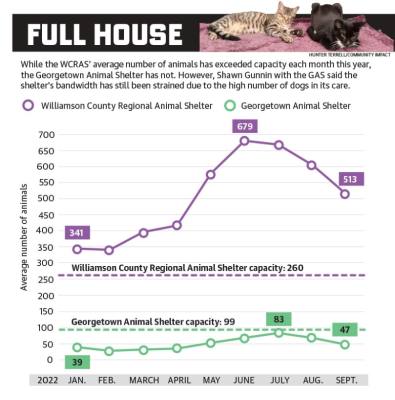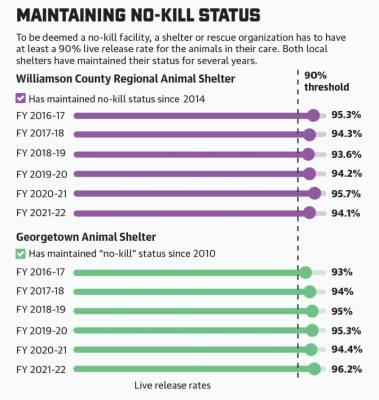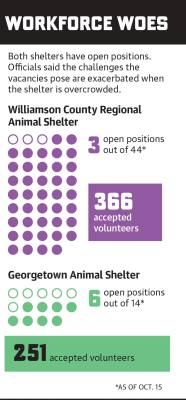April Peiffer, Williamson County Regional Animal Shelter program coordinator, said in July, the shelter reached its peak capacity for fiscal year 2021-22—having more than 674 animals in its care. The facility is designed to hold 260 maximum.
WCRAS staff said the facility had 552 animals in September.
Meanwhile, while the overall number of animals at the Georgetown Animal Shelter has not exceeded its capacity of 99, officials there said the shelter has consistently cared for more dogs than available kennels.
Shawn Gunnin, program coordinator at Georgetown Animal Shelter, said the cat population at the shelter has been light this year but varies between 20-100 kittens at a time.
“It’s been a tough time, and I am anxious as to what’s to come,” Gunnin said.
One potential solution would be building an addition to the Georgetown shelter or consolidating its operations with those of the WCRAS.
With both facilities consistently facing overcrowding, financial struggles and understaffing, Peiffer and Gunnin said they have been overwhelmed for months, if not years.
“I can’t remember the last time we were comfortable,” Peiffer said.
Over capacity
The WCRAS—which serves the cities of Round Rock, Cedar Park, Hutto and Leander as well as unincorporated regions of Williamson County—was already facing hard times when the COVID-19 pandemic hit, Peiffer said.
In fiscal year 2017-18, the WCRAS took in 2,689 cats and 3,664 dogs.
“Being forced to close our doors [during the pandemic] to walk-ins and potential adopters and fosters impacted our staff and resources tremendously,” Peiffer said. “Not to mention the safety concerns for our staff and volunteers. We had to put in a lot of work to keep our operations afloat.”
During that time, the organization placed major emphasis on fostering and curbside services.
“The community reacted well to our shift in services,” Peiffer said. “But the number of intakes did not slow.”
Peiffer said fostering allows the facility to open up space for at least two weeks as more animals come in.
Located 4 miles north of the WCRAS, Georgetown’s shelter had a similarly tough time following the height of the pandemic.
Gunnin said she thinks because people did and still are experiencing financial hardships and employment issues, more people have had to unexpectedly surrender their pets.
“COVID was a hard time for everyone,” Gunnin said. “Unfortunately, it hasn’t gotten much better.”
Aside from accepting surrenders and strays, both facilities work closely with animal control departments, including taking on animals from cruelty cases.
In August, the WCRAS had to take in 44 animals from a cruelty case when the facility already had more than 400 animals in its care.
“Circumstances like that push us to our limit,” Peiffer said.
Peiffer and Gunnin said the summation of animals from cruelty cases and from everyday surrenders has taken a toll on their resources and staff.
“We can’t predict these situations,” Gunnin said. “So when something like a cruelty case happens, we have to work with what we got.”
Ongoing challenges
Gunnin and Peiffer agreed funding levels for the animal shelters are not enough to support staff and operational needs.
“We are grateful for the money that we receive from our community leadership,” Peiffer said. “But when we are overwhelmed by animal intake, funds can diminish quicker than expected.”
In FY 2021-22, the WCRAS received a total of $2.6 million from its serviced jurisdictions with 56.87% of that from Williamson County, 20.89% from Round Rock, 9.74% from Cedar Park, 7.17% from Leander and 5.53% from Hutto.
The Georgetown shelter had a FY 2021-22 budget of $1.2 million, included in the city’s general fund.
Both entities rely on donations and fundraising efforts.
“Residents are very supportive of our programs,” Gunnin said. “Even if they just drop off a bag of dog food, every little bit counts.”
The Georgetown shelter receives local donations from the Friends of the Georgetown Animal Shelter, a nonprofit that has raised more than $19,000 in 2022.
Similarly, the WCRAS has received annual support from national nonprofit Petco Love.
“The Williamson County Animal Shelter is one of the most effective and productive organizations in the region,” Petco Love President Susanne Kogut said. “We are proud to have invested over $1 million to support [Williamson County] and their work.”
The WCRAS 2021-22 annual report shows the shelter received an additional $684,731 from community donations and grants.
Another challenge facing the local shelters is staffing.
As of Oct. 15, the Georgetown shelter had six out of 14 staff positions vacant, and the WCRAS had three out of 44.
Peiffer said while these numbers may seem small, they are significant when caring for double or even triple the amount of animals the facility is designed for.
Gunnin and Peiffer said even if all their positions were filled tomorrow, they would still need volunteers to operate smoothly.
“Just coming in and taking a dog for a walk is a big help,” Georgetown volunteer Felicia Drummond said. “They never ask you to do something you’re not comfortable with, and you do it on your own time.”
Gunnin said the shelter has accepted 251 volunteers, but only 64 have completed time.
Comparatively, the WCRAS 2021-22 annual report states the shelter had accepted 366 volunteers, but not all committed hours.
“I am thankful for all the employees and volunteers who give their time and effort at the Williamson County Regional Animal Shelter,” Williamson County Precinct 3 Commissioner Valerie Covey said. “We could never operate a successful shelter without them.”
Future partnership
With the county quickly growing, Peiffer and Gunnin said the region will more than likely have to serve more animals.
In response, Williamson County Judge Bill Gravell said the county will take the appropriate steps as more information becomes available.
“We value our animals in Williamson County and are always assessing their needs,” Gravell said. “We are keeping a close eye on the growing number of animals the shelter continues to see and the possible need for expansion in the future.”
In 2019, the city of Georgetown conducted a study that showed the need for increased shelter capacity. That necessary expansion would cost the city about $7 million, according to city documents.
The study also proposed another solution—the Georgetown Animal Shelter could be absorbed into the WCRAS. Under this model, Georgetown would contribute a portion of the WCRAS annual budget.
According to a Georgetown city official, both parties gave their staff directions over the summer to explore a possible partnership.
“I am looking forward to discussions regarding additional or improved •sheltering facilities to better serve the current and future needs of this community in the most cost-effective manner,” Georgetown Mayor Josh Shroeder said.
City documents state no formal decisions have been made yet. Georgetown Communications Officer Keith Hutchinson said any future agreement would need to be approved by the WCRAS board, all WCRAS members and Georgetown City Council.
“Whatever the outcome, we are all in this profession for the same reason: to help the animals in our community,” Gunnin said.










